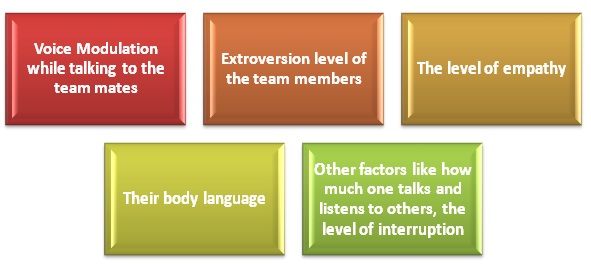A major challenge for the organizations is to develop teams to optimize the synergy and eradicate the possibilities of conflicts. While most of them realize, efficient communication is the key to achieve esprit de corps, they do not realize that the success mantra does not just lie in what is communicated but how it is communicated and that encompasses a set of factors, based on the pillars: Energy, Engagement and Exploration. This has practically transformed the team building exercise from art to science with a set of protocols that we will discuss in the course of the discussion.
 Communication in a team
Communication in a team
According to a survey conducted by the human dynamics department of MIT university, the overall performance can be based on the analysis of the following nuances of human behavior when working in a team:

On the basis of the study of these factors vis-à-vis the performance of the team, following observations were made:
1) The talent and knowledge level of the team members is secondary to the performance of the team, what matters most is gauging their communication patterns and training them to hone them in the right direction.
2) The members communicate not just with the team leader but equally with the entire team.
3) The overall gestures of the team members are energetic and focus on addressing each of them in the conversation.
4) Each member is given a chance to express his viewpoint, wherein every one listens to every other and also ensures that he speaks precisely and to the point.
5) The team members are not just restricted to the team ideas but explore new channels to grab new ideas and enrich the team as a whole.
The 3 Es
Let us take a look on these 3 import
1) Energy
This factor keeps varying depending on the situation under consideration. Elated events would normally boost the overall energy levels while the challenges may sometimes lower the energy levels.
2) Engagement
This is the overall distribution of energy in the team. Lets us consider a team comprising of 3 members X, Y and Z. So the engagement can be calculated as the average of energy between X and Y, Y and Z and X and Z. Thus, a strong engagement would be achieved when there is a high level interaction between every member.
3) Exploration
It is interesting to note that the success of the team is not just restricted to the internal communication levels but also to the external ones. This is the channelizing of the energy to other teams, to gain insights enriching the overall team performance. This becomes particularly significant to teams involved in innovative tasks, as it helps to gain fresh insights. The team members need to interact with their back and side channels to explore new perspectives.
The conservation of energy principle states that “energy can neither be created nor destroyed, it can only be transformed from one form to another”. So with finite energy, the engagement and exploration lie at a tradeoff situation, wherein more focus on one leads to sacrificial effect on the other. So, if energy is concentrated inside the team, the energy allocation for exploration is reduced.
Understanding the overall dynamics
Visualization is an effective way to understand the overall energy distribution, the engagement levels (in case of disparity, identifying the unengaged and the dominant ones) and the exploration levels. This can be done on 2 criteria:
- Mapping w.r.t the team members
- Mapping w.r.t time
- 1) EnergyThis factor keeps varying depending on the situation under consideration. Elated events would normally boost the overall energy levels while the challenges may sometimes lower the energy levels.2) EngagementThis is the overall distribution of energy in the team. Lets us consider a team comprising of 3 members X, Y and Z. So the engagement can be calculated as the average of energy between X and Y, Y and Z and X and Z. Thus, a strong engagement would be achieved when there is a high level interaction between every member.3) ExplorationIt is interesting to note that the success of the team is not just restricted to the internal communication levels but also to the external ones. This is the channelizing of the energy to other teams, to gain insights enriching the overall team performance. This becomes particularly significant to teams involved in innovative tasks, as it helps to gain fresh insights. The team members need to interact with their back and side channels to explore new perspectives.The conservation of energy principle states that “energy can neither be created nor destroyed, it can only be transformed from one form to another”. So with finite energy, the engagement and exploration lie at a tradeoff situation, wherein more focus on one leads to sacrificial effect on the other. So, if energy is concentrated inside the team, the energy allocation for exploration is reduced.Understanding the overall dynamicsVisualization is an effective way to understand the overall energy distribution, the engagement levels (in case of disparity, identifying the unengaged and the dominant ones) and the exploration levels. This can be done on 2 criteria:
- Mapping w.r.t the team members
- Mapping w.r.t time
No comments:
Post a Comment